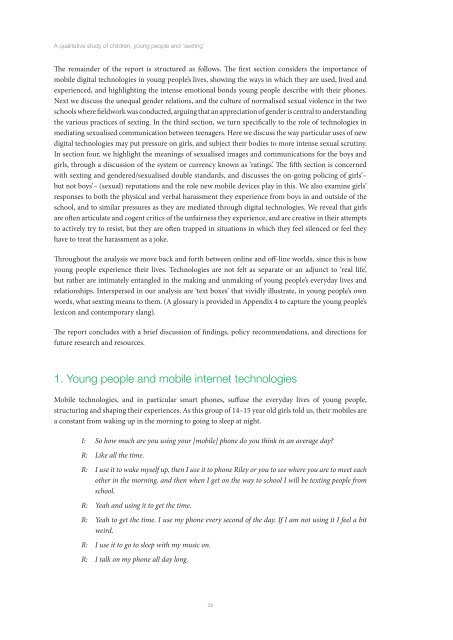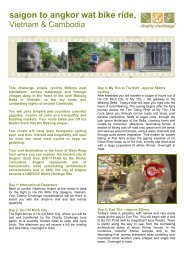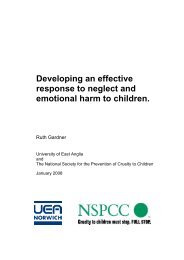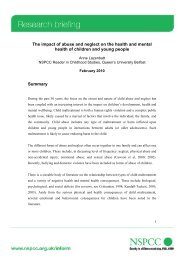A qualitative study of children, young people and 'sexting ... - NSPCC
A qualitative study of children, young people and 'sexting ... - NSPCC
A qualitative study of children, young people and 'sexting ... - NSPCC
You also want an ePaper? Increase the reach of your titles
YUMPU automatically turns print PDFs into web optimized ePapers that Google loves.
A <strong>qualitative</strong> <strong>study</strong> <strong>of</strong> <strong>children</strong>, <strong>young</strong> <strong>people</strong> <strong>and</strong> ‘sexting’<br />
The remainder <strong>of</strong> the report is structured as follows. The first section considers the importance <strong>of</strong><br />
mobile digital technologies in <strong>young</strong> <strong>people</strong>’s lives, showing the ways in which they are used, lived <strong>and</strong><br />
experienced, <strong>and</strong> highlighting the intense emotional bonds <strong>young</strong> <strong>people</strong> describe with their phones.<br />
Next we discuss the unequal gender relations, <strong>and</strong> the culture <strong>of</strong> normalised sexual violence in the two<br />
schools where fieldwork was conducted, arguing that an appreciation <strong>of</strong> gender is central to underst<strong>and</strong>ing<br />
the various practices <strong>of</strong> sexting. In the third section, we turn specifically to the role <strong>of</strong> technologies in<br />
mediating sexualised communication between teenagers. Here we discuss the way particular uses <strong>of</strong> new<br />
digital technologies may put pressure on girls, <strong>and</strong> subject their bodies to more intense sexual scrutiny.<br />
In section four, we highlight the meanings <strong>of</strong> sexualised images <strong>and</strong> communications for the boys <strong>and</strong><br />
girls, through a discussion <strong>of</strong> the system or currency known as ‘ratings’. The fifth section is concerned<br />
with sexting <strong>and</strong> gendered/sexualised double st<strong>and</strong>ards, <strong>and</strong> discusses the on-going policing <strong>of</strong> girls’–<br />
but not boys’– (sexual) reputations <strong>and</strong> the role new mobile devices play in this. We also examine girls’<br />
responses to both the physical <strong>and</strong> verbal harassment they experience from boys in <strong>and</strong> outside <strong>of</strong> the<br />
school, <strong>and</strong> to similar pressures as they are mediated through digital technologies. We reveal that girls<br />
are <strong>of</strong>ten articulate <strong>and</strong> cogent critics <strong>of</strong> the unfairness they experience, <strong>and</strong> are creative in their attempts<br />
to actively try to resist, but they are <strong>of</strong>ten trapped in situations in which they feel silenced or feel they<br />
have to treat the harassment as a joke.<br />
Throughout the analysis we move back <strong>and</strong> forth between online <strong>and</strong> <strong>of</strong>f-line worlds, since this is how<br />
<strong>young</strong> <strong>people</strong> experience their lives. Technologies are not felt as separate or an adjunct to ‘real life’,<br />
but rather are intimately entangled in the making <strong>and</strong> unmaking <strong>of</strong> <strong>young</strong> <strong>people</strong>’s everyday lives <strong>and</strong><br />
relationships. Interspersed in our analysis are ‘text boxes’ that vividly illustrate, in <strong>young</strong> <strong>people</strong>’s own<br />
words, what sexting means to them. (A glossary is provided in Appendix 4 to capture the <strong>young</strong> <strong>people</strong>’s<br />
lexicon <strong>and</strong> contemporary slang).<br />
The report concludes with a brief discussion <strong>of</strong> findings, policy recommendations, <strong>and</strong> directions for<br />
future research <strong>and</strong> resources.<br />
1. <strong>young</strong> <strong>people</strong> <strong>and</strong> mobile internet technologies<br />
Mobile technologies, <strong>and</strong> in particular smart phones, suffuse the everyday lives <strong>of</strong> <strong>young</strong> <strong>people</strong>,<br />
structuring <strong>and</strong> shaping their experiences. As this group <strong>of</strong> 14–15 year old girls told us, their mobiles are<br />
a constant from waking up in the morning to going to sleep at night.<br />
I: So how much are you using your [mobile] phone do you think in an average day?<br />
R: Like all the time.<br />
R: I use it to wake myself up, then I use it to phone Riley or you to see where you are to meet each<br />
other in the morning, <strong>and</strong> then when I get on the way to school I will be texting <strong>people</strong> from<br />
school.<br />
R: Yeah <strong>and</strong> using it to get the time.<br />
R: Yeah to get the time. I use my phone every second <strong>of</strong> the day. If I am not using it I feel a bit<br />
weird.<br />
R: I use it to go to sleep with my music on.<br />
R: I talk on my phone all day long.<br />
26
















